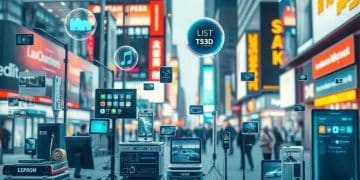Future trends in transportation industry: what to expect

Future trends in the transportation industry are heavily influenced by consumer preferences for eco-friendly options, technological integration, and convenient, multi-modal solutions that shape innovations going forward.
Future trends in transportation industry will revolutionize how we move, making it smarter and more sustainable. Have you considered how these changes could affect your daily commute? Let’s dive in!
Emerging technologies transforming transportation
Emerging technologies are reshaping the transportation industry in exciting ways. These advancements are not just making travel faster but also more efficient and sustainable. As we explore these technologies, we will witness a significant impact on how goods and people move across different landscapes.
Impact of Electric Vehicles
One of the most notable trends is the rise of electric vehicles (EVs). EVs reduce our reliance on fossil fuels, making transportation cleaner. Moreover, with promises of reduced cost over time and growing charging infrastructure, they are becoming a practical choice for consumers.
- Lower operational costs compared to gasoline vehicles
- Reduction in greenhouse gas emissions
- Government incentives encouraging purchase
Beyond EVs, other technologies like autonomous vehicles are also on the horizon. These self-driving cars aim to enhance safety and efficiency, potentially reducing traffic accidents by minimizing human error. Imagine a world where your car can drive itself while you relax or catch up on work!
Integration of Smart Technologies
Another exciting aspect is the integration of smart technologies in transportation. Smart infrastructure, which includes sensors and communication technologies, allows for real-time data collection. This helps manage traffic flows better and makes transportation systems more responsive to the needs of users.
Alongside these developments, the sharing economy is also making waves. Platforms that facilitate ride-sharing and bike-sharing are transforming how we think about owning a vehicle. Accessing transportation services is now often a better option than ownership, especially in urban settings.
- Improved accessibility for all demographics
- Reduction in congestion with shared rides
- Increased convenience with on-demand services
In conclusion, as these emerging technologies continue to evolve, we can expect our transportation systems to become more sustainable, efficient, and user-friendly. Embracing these changes can lead to a greener future with enhanced mobility for everyone.
Impact of sustainability on transportation trends

Sustainability is playing a crucial role in shaping the future of the transportation industry. As we become more aware of climate change and its effects, there is a growing emphasis on finding green solutions for transportation.
The Rise of Renewable Energy
One of the significant impacts of sustainability is the transition to renewable energy sources. Electric vehicles, powered by solar and wind energy, are becoming more common. This shift helps reduce emissions and reliance on fossil fuels, paving the way for a cleaner environment.
- Solar and wind power for electric vehicles
- Increased investments in charging infrastructure
- Government policies supporting renewable energy adoption
Additionally, public transit systems are also adapting. Many cities are investing in electric buses and trains, which offer a sustainable alternative to traditional diesel vehicles. This change not only lowers emissions but also improves air quality in urban areas.
Innovations in Sustainable Practices
Beyond vehicles, the concept of sustainability extends to overall transportation practices. For example, urban planning is now increasingly focused on creating walkable cities. Encouraging walking and cycling reduces traffic congestion and emissions from vehicles.
Moreover, the sharing economy promotes sustainability as well. Ride-sharing platforms and carpooling options help decrease the number of vehicles on the road. This approach allows individuals to travel efficiently while minimizing their carbon footprint.
- Boosting local economies through shared services
- Promoting multi-modal transport solutions
- Reducing dependence on individual car ownership
The focus on sustainability in transportation trends is not just beneficial for the planet; it also creates opportunities for innovation. As more companies prioritize environmentally friendly options, we can expect to see exciting advancements in technology and practices aimed at fostering a sustainable future.
The role of urbanization in future transportation
Urbanization is a key factor influencing the future of the transportation industry. As cities continue to grow, they present both challenges and opportunities for how we move around. Understanding this role is essential for developing effective transportation solutions.
Increased Demand for Public Transit
As urban areas expand, the demand for efficient public transit systems increases. More people living in close quarters means a greater need for reliable options to avoid congestion. Cities are investing in subways, buses, and light rail, making it easier for residents to commute.
- Enhanced accessibility through public transport options
- Decreased reliance on personal vehicles
- Reduced traffic congestion in urban areas
This shift not only benefits daily commuters but also contributes to sustainability goals. A robust public transit system can lower carbon emissions, promoting a healthier environment.
Smart City Initiatives
Urbanization is also driving the implementation of smart city technologies. These innovations integrate data and technology into transportation systems for improved efficiency. By using real-time data, cities can manage traffic flows and reduce wait times.
For instance, smart traffic lights adjust their timings based on vehicle and pedestrian movements. This leads to more fluid traffic patterns and less idling, which is beneficial for the environment.
- Improved safety with better traffic management
- Enhanced convenience for drivers and pedestrians
- Maintenance of infrastructure through automated systems
Furthermore, urban planning is adapting to create walkable communities. City planners are emphasizing mixed-use developments that encourage walking and biking, reducing the need for cars. This not only fosters a sense of community but also helps maintain cleaner air.
In summary, urbanization plays a crucial role in shaping the future of transportation. As cities adapt to growth, strategies that promote public transit and smart technologies will lead to improved mobility and sustainability.
How consumer preferences are shaping transportation innovations

Consumer preferences significantly influence transportation innovations. As people’s needs and desires change, the transportation industry must adapt to meet these expectations. Understanding these shifts helps businesses create solutions that resonate with users.
Shift Towards Eco-Friendly Options
One of the most notable trends is a growing demand for eco-friendly transportation. More consumers are prioritizing sustainability and looking for green alternatives. This shift is driving companies to design electric vehicles (EVs) and promote public transit options.
- Increased interest in hybrid and fully electric vehicles
- Demand for reduced emissions in transportation
- Popularity of shared mobility services
As consumers express a preference for cleaner options, manufacturers are innovating faster than ever. Businesses are exploring biodegradable materials and energy-efficient designs to keep up with environmentally conscious buyers.
Emphasis on Convenience and Technology
Additionally, the importance of convenience has shaped how innovations are developed. Consumers today expect seamless experiences in their daily travels. This expectation has led to the rise of mobile apps that simplify ride-hailing, route planning, and ticket purchases.
Smart technologies like GPS and real-time tracking are becoming essential. As users demand more information about their journeys, companies are integrating technology into their services to enhance user experience.
- Growth of on-demand ride services
- Integration of AI for personalized travel recommendations
- Development of user-friendly interfaces for transportation apps
Moreover, there is a noticeable trend towards multi-modal transportation. Consumers are looking for flexible options that combine different modes of transport, like bikes, buses, and trains, to create a comprehensive travel experience that suits their lifestyle. This demand encourages innovations that promote easy transitions between various transport types.
Overall, consumer preferences are a driving force behind the changes we see in the transportation industry. By focusing on sustainability, technology, and convenience, businesses can create innovations that meet the dynamic needs of today’s users.
FAQ – Frequently Asked Questions about Transportation Innovations
How are consumer preferences driving transportation changes?
Consumer preferences are focused on sustainability and convenience, which pushes companies to innovate and create eco-friendly and user-friendly transportation options.
What role does technology play in modern transportation?
Technology enhances convenience through apps that allow for easy ride-hailing, real-time tracking, and improved safety features in vehicles.
Why is eco-friendliness important in transportation today?
Eco-friendliness reduces carbon emissions and promotes a healthier environment, aligning with the values of a growing number of consumers.
What is multi-modal transportation, and why is it gaining popularity?
Multi-modal transportation combines different travel methods, like biking and public transport, allowing for more flexibility and efficiency in urban travel.





